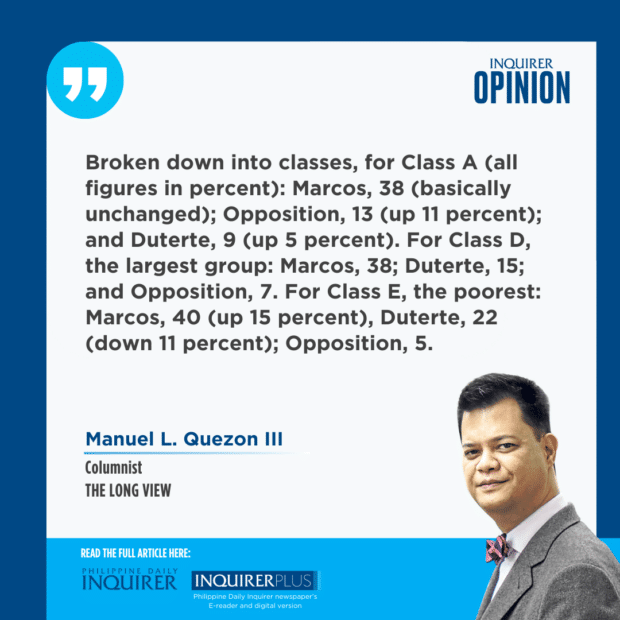Strong and weak

The battlelines are revealed by OCTA Research, which reports as of September (all figures in percent) the following: “Pro-Marcos,” 38; “Pro-Duterte,” 15; and “Pro-Opposition” 7 (apparently meaning the Center-Left represented by Sen. Risa Hontiveros). Another 26 percent consider themselves “Independents” while 14 percent are “Undecided” or “Refused.” The proportions remain virtually unchanged since they were last reported in July.
It’s in the subsets that the picture becomes clearer and more interesting (I’ll only mention changes if they are above the usual margin of error of 1-3 percent). In Metro Manila, the pros, respectively, are: Marcos, 42; Opposition, 10 (which gained 5 percent since July), Duterte, 6. For Balance Luzon: Marcos, 43; Opposition, 5; Duterte, 3. For the Visayas: Marcos, 37 (up 5 percent since July); Opposition, 14; Duterte, 12. And for Mindanao: Duterte, 48; Marcos, 25; Opposition, 4 (up 100 percent since July).
Broken down into classes, for Class A (again, all figures in percent): Marcos, 38 (basically unchanged); Opposition, 13 (up 11 percent); and Duterte, 9 (up 5 percent). For Class D, the largest group: Marcos, 38; Duterte, 15; and Opposition, 7. For Class E, the poorest: Marcos, 40 (up 15 percent), Duterte, 22 (down 11 percent); Opposition, 5
Since May (a year ahead of the 2025 midterms, when I enumerated their respective standings), the situation of the parties has evolved further.
In the House of Representatives, of the two traditional parties, the Partido Demokratiko Pilipino (PDP) has gone from 10 to merely one; but Lakas-CMD gained, going from 100 to 111. For the parties that are essentially commercial subsidiaries, the Nacionalistas went from 36 to 28; the Nationalist People’s Coalition, from 38 to 37; and the National Unity Party, from 36 to 40. As to the nominal affiliations of the President and Vice President, respectively: the Partido Federal ng Pilipinas, from 13 to 10; and the Hugpong ng Pagbabago, still only has one congressperson.
Taking another look at the local arena, PDP since May is down to four governorships (from 14); Lakas-CMD went from eight to 14; the Partido Federal has gone from 29 to 33, while Hugpong ng Pagbabago seems to still have none at all.
We can assume these numbers are familiar to the decision-makers and strategists on all sides and to those interested in lending their support to their slates, local and national.
The framework I’ve found particularly useful in looking at the coalitions that are assembled to contest elections is one put forward by the historian Mina Roces, who wrote we should bear three ideas in mind: “palakasan,” “malakas,” and “mahina.”
To her, “Palakasan is a system wherein those in power compete with each other in obtaining special privileges and exemptions from regulations and bending the rules of law for their kinship group. For the palakasan system to function, there must be various groups of family rivals all attempting to exercise power in the pursuit of family wealth and privilege. Each family then tries to outdo the other in being malakas.”
“But malakas status,” she points out, “is not dependent on social or economic class … Since the criterion for malakas status is solely political power, a wealthy person can lose out to a relatively poor but more influential family alliance. A group of squatters in a Manila slum area may be malakas because they have close ties with the mayor and therefore feel no threat of eviction. The person who owns the land illegally occupied by the squatters though wealthy, has no hope of retrieving his/her land or of evicting the squatters as long as these squatters maintain their malakas status vis-à-vis the mayor …
“It is true that, generally, wealthy families have more chances of attaining malakas status: politicians are willing to receive financial assistance from a wealthy family at election time in exchange for ties of utang na loob. Wealthy families are also financially capable of employing someone who is malakas in order to speak in their favor. For example, rich families can pay influential malakas lawyers, or malakas judges to favor them in court. A poor person who is mahina would not have the financial materiel to approach a malakas person for help. But it is important to note that even families from low social classes, the poor peasants, may be malakas if they are close to the powers that be. Don Alfonso may be wealthy but he could be mahina in the municipality of Pasay City, whereas, Mang Pedro who is the bodyguard of Mayor Pablo Cuneta of Pasay City could be malakas in that municipality.”
Because of this, Roces argues that being malakas isn’t always about the wallop of one’s wallet: “Malakas highlights inequalities not along socioeconomic class lines but distinguishes between those who are exempted from all laws and rules that govern the rest of society (malakas) and those who have to follow the rules (mahina) … An interesting point is that in order to show malakas status, one has to break the rules deliberately; one has to exercise status to show status.”
1 thought on “The Long View: Strong and weak”